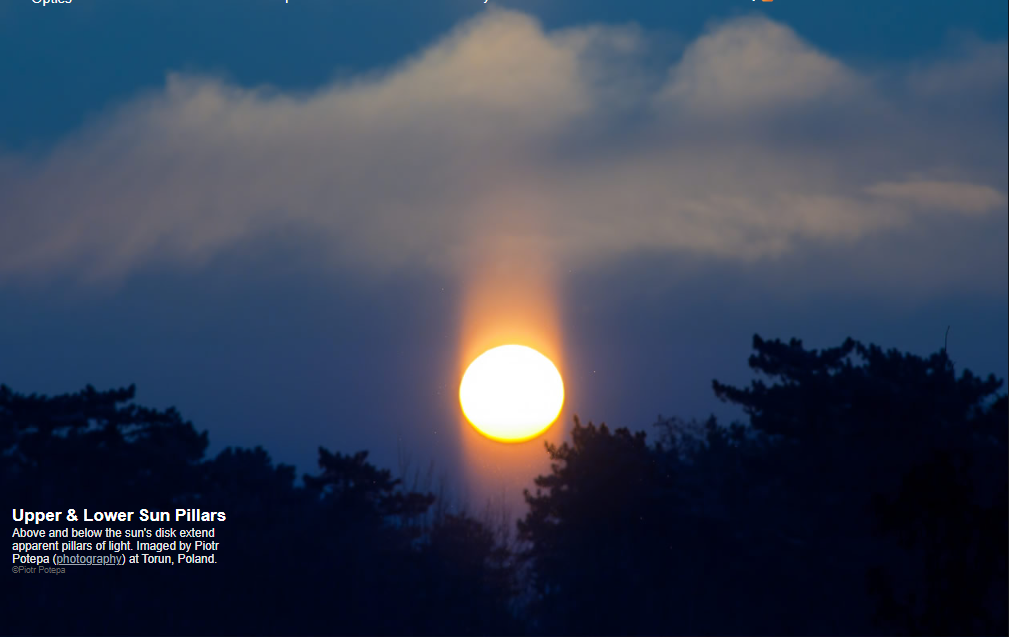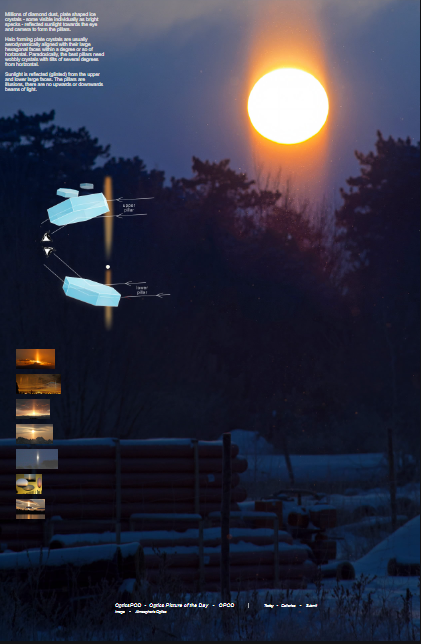OPOD - Two Pillars
OPOD - Two Pillars: A Spectacular Atmospheric Phenomenon
Have you ever witnessed a mesmerizing display of light pillars extending above and below the sun's disk? These captivating phenomena, known as upper and lower sun pillars, create a stunning visual spectacle in the sky. In this article, we will delve into the science behind these optical illusions and explore the factors that contribute to their formation.
The Magical Dance of Diamond Dust
To understand the formation of sun pillars, we must first acquaint ourselves with diamond dust. These are millions of tiny, plate-shaped ice crystals suspended in the atmosphere. When sunlight interacts with these minuscule crystals, they reflect the light towards our eyes and cameras, resulting in the enchanting pillars we observe.
The Role of Crystal Orientation
Interestingly, the formation of halo-forming plate crystals, which are typically aligned aerodynamically, differs from the crystals responsible for sun pillars. While halo-forming crystals have their large hexagonal faces nearly horizontal, the crystals that generate the most remarkable pillars exhibit a slight wobble with tilts of several degrees from the horizontal plane.
The Illusion of Beams
It is crucial to note that sun pillars are illusions; there are no actual beams of light extending upwards or downwards. Instead, sunlight glints off the upper and lower large faces of the tilted ice crystals, creating the illusion of radiant columns of light. These pillars appear to extend infinitely into the sky or ground, depending on their orientation.
The Optics Behind Sun Pillars
The formation of sun pillars can be attributed to a phenomenon called light scattering. When light encounters small particles or objects, such as ice crystals in the atmosphere, it scatters in various directions. In the case of sun pillars, the scattered light from the crystals aligns in a vertical orientation, creating the illusion of elongated pillars surrounding the sun.
Atmospheric Conditions and Pillar Intensity
The intensity and visibility of sun pillars are influenced by several atmospheric conditions. Here are some factors that can affect the appearance of these optical phenomena:
- The concentration and size of the diamond dust crystals in the atmosphere.
- The angle at which the crystals are tilted from the horizontal plane.
- The presence of other particles or pollutants in the atmosphere, which can enhance or diminish the pillar's visibility.
- The position of the observer relative to the sun and the crystals, as different viewing angles can alter the appearance of the pillars.
Sun Pillars Around the World
Sun pillars can occur in various locations worldwide, as long as the necessary atmospheric conditions are present. While they are most commonly observed in colder regions, such as polar areas or during winter months, they can also manifest in other climates under specific circumstances.
Photographing Sun Pillars
Capturing the beauty of sun pillars through photography can be a rewarding experience. To photograph these ethereal phenomena, it is essential to consider the following tips:
- Choose a location with a clear view of the sky and minimal light pollution.
- Utilize a tripod to ensure stability and reduce camera shake.
- Adjust your camera settings to capture the pillars' subtle details, such as increasing exposure time and using a low ISO setting.
- Experiment with different angles and compositions to create visually striking images.
Appreciating Nature's Artistry
Witnessing upper and lower sun pillars is an awe-inspiring reminder of nature's artistic prowess. These atmospheric phenomena offer a glimpse into the intricate interplay between light and ice crystals in our atmosphere. The next time you find yourself gazing at the sky, keep an eye out for these remarkable optical illusions and marvel at the beauty that surrounds us.
References

Upper & Lower Sun Pillars
Above and below the sun's disk extend apparent pillars of light. Imaged by Piotr Potepa (photography) at Torun, Poland.
©Piotr Potepa

Millions of diamond dust, plate shaped ice crystals - some visible individually as bright specks - reflected sunlight towards the eye and camera to form the pillars.
Halo forming plate crystals are usually aerodynamically aligned with their large hexagonal faces within a degree or so of horizontal. Paradoxically, the best pillars need wobbly crystals with tilts of several degrees from horizontal.
Sunlight is reflected (glinted) from the upper and lower large faces. The pillars are illusions, there are no upwards or downwards beams of light.
Note: this article has been automatically converted from the old site and may not appear as intended. You can find the original article here.
Reference Atmospheric Optics
If you use any of the definitions, information, or data presented on Atmospheric Optics, please copy the link or reference below to properly credit us as the reference source. Thank you!
-
<a href="https://atoptics.co.uk/blog/opod-two-pillars/">OPOD - Two Pillars</a>
-
"OPOD - Two Pillars". Atmospheric Optics. Accessed on April 20, 2024. https://atoptics.co.uk/blog/opod-two-pillars/.
-
"OPOD - Two Pillars". Atmospheric Optics, https://atoptics.co.uk/blog/opod-two-pillars/. Accessed 20 April, 2024
-
OPOD - Two Pillars. Atmospheric Optics. Retrieved from https://atoptics.co.uk/blog/opod-two-pillars/.